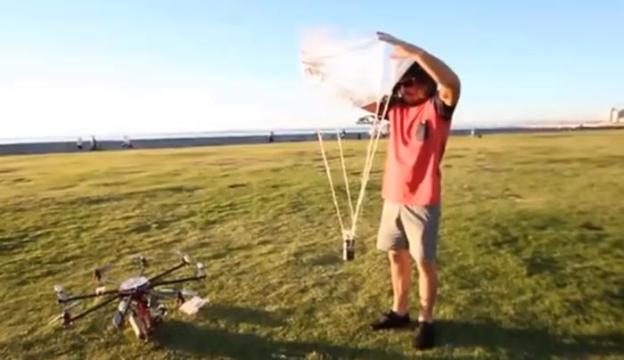
Demoed in a recently posted YouTube video, an octocopter drone that delivers beer is being developed by a team that’s working with the OppiKoppi Music Festival in South Africa. Called the OppiKoppi Beer Drone, cans of beer are loaded into the drone prior to taking off and each can is attached to a clear, plastic parachute. After the drone reaches the approximate location of the person that requested the beer in addition to the appropriate altitude to safely drop the brew, the drone releases the can. Assuming the parachute opens correctly, the can safely glides to the ground into the hands of the thirsty festival attendee.

Assuming the festival attendee has downloaded a smarpthone application distributed by the creators of OppiKoppi Beer Drone, they will be able to place an order for a beer without having to leave the campsite. The developers haven’t estimated how long it will take to deliver each beer, but hope to automate the process with the GPS grid.
It’s unclear if the OppiKoppi Beer Drone can handle more than one can at a time. The total amount of weight that a multi-rotor aircraft can carry is dependent on the overall size of the drone in addition to the speed of the blades. Movement of the drone is controlled by altering the speed of each rotor. It’s possible that strong winds could interfere with the operation of the OppiKoppi Beer Drone. Battery power could also be an issue over time, assuming the drones will be used constantly during the festival. The team will need charged battery packs ready to go all day when the drones are delivering beers.
Definitively a quirky use of drones and mobile technology, there are definitely a number of issues that could be troublesome with this system. Beer cans could easily float to the wrong location and get consumed by someone that didn’t even order the beer.

If the parachute fails to expand, a plummeting beer can could cause a serious medical problem for someone at the festival. Beyond that, anyone that’s had too much to drink already may have trouble even tracking down a beer can that’s descending from above.
While this is definitely the first beer delivering drone in the world, this isn’t the first time that someone has created an airborne delivery system for a tasty snack. Developed by Darwin Aerospace, the Burrito Bomber is a drone that air drops a delicious burrito on a specific waypoint. Completely different in design from a quadrocopter, the Burrito Bomber looks more like a stealth bomber used by the military. After someone orders a burrito using a smartphone application, their GPS location is uploaded to the team’s server and the drone is launched. While the drone can be flown manually by watching the video feed, the Burrito Bomber can also fly automatically when controlled by the Ardupilot autopilot.
Editors' Recommendations
- Using drones to detect coronavirus? It’s not as crazy as it sounds
- Uber Eats is close to delivering your dinner using a drone
- A giant new solar farm in Texas will harness the sun’s rays to … brew beer?


